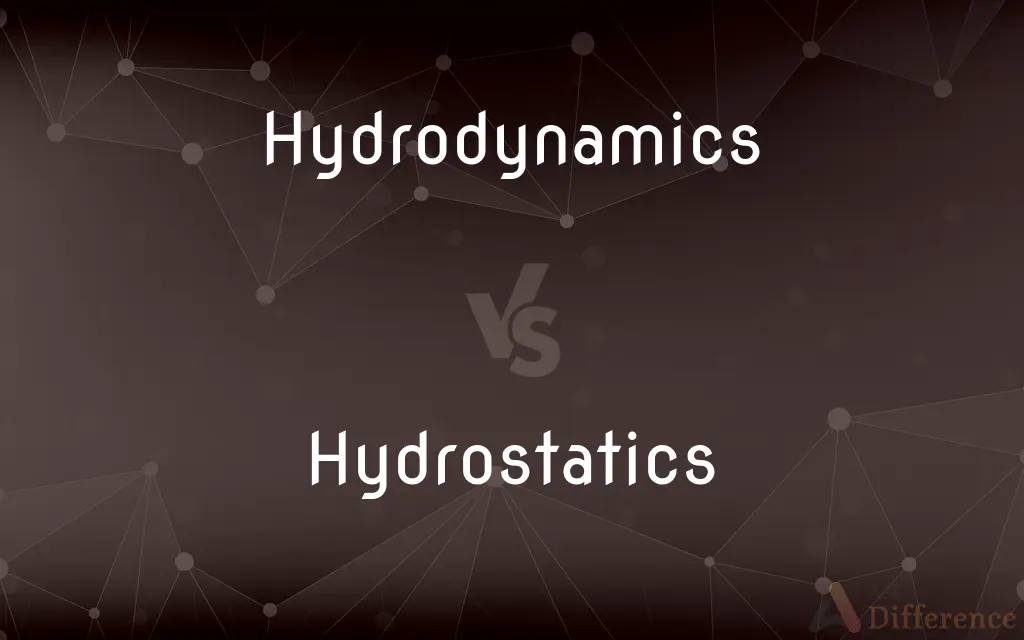Hydrodynamics vs. Hydrostatics — What's the Difference?
By Urooj Arif & Fiza Rafique — Updated on April 4, 2024
Hydrodynamics studies fluid motion, focusing on forces causing flow. Hydrostatics examines fluids at rest, emphasizing pressure in equilibrium.

Difference Between Hydrodynamics and Hydrostatics
Table of Contents
ADVERTISEMENT
Key Differences
Hydrodynamics is a branch of physics that deals with the study of fluids in motion and the forces that affect them. This includes the analysis of flow patterns, velocity fields, and the influence of viscosity. On the other hand, hydrostatics focuses on fluids at rest, primarily concerned with understanding how pressure varies within a fluid at equilibrium, such as in lakes or tanks.
In hydrodynamics, the Bernoulli’s equation is a fundamental principle used to relate the speed of a fluid and its pressure along a streamline. This equation helps predict how a fluid will behave when it is in motion, considering factors like flow rate and energy conservation. Whereas in hydrostatics, the key principle is Pascal’s Law, which states that pressure exerted anywhere in a confined incompressible fluid is transmitted equally in all directions throughout the fluid, affecting submerged objects regardless of their shape.
Hydrodynamics often requires complex mathematical models to describe the behavior of fluids in motion, taking into account turbulence, laminar flow, and the Reynolds number, which helps predict flow patterns in different fluid flow situations. Hydrostatics, in contrast, involves simpler calculations, primarily focusing on the hydrostatic pressure equation, which describes how pressure increases with depth in a fluid, demonstrating a direct relationship between depth, density, and gravitational acceleration.
The study of hydrodynamics is crucial in designing and analyzing systems where fluid flow is key, such as in hydraulic engineering, aeronautics, and marine navigation. It helps engineers optimize designs for efficiency and performance, considering factors like drag and lift. Hydrostatics, on the other hand, is essential in understanding the principles behind the buoyancy of objects, the design of dams, and the analysis of fluid pressure in static situations, playing a vital role in civil engineering and architecture.
Applications of hydrodynamics extend into fields like meteorology, where it aids in understanding atmospheric circulation patterns, and in medicine, for blood flow analysis within the cardiovascular system. Hydrostatics finds its applications in determining the stability of ships, the design of fluid storage tanks, and in various engineering projects involving the management and containment of liquids.
ADVERTISEMENT
Comparison Chart
Focus
Fluid motion
Fluids at rest
Key Principles
Bernoulli’s equation, Reynolds number
Pascal’s Law, hydrostatic pressure
Calculations
Complex, involving dynamics of flow
Simpler, focusing on pressure distribution
Applications
Hydraulic engineering, aeronautics, marine navigation
Buoyancy analysis, dam design, architecture
Relevant Fields
Meteorology, medicine (blood flow)
Civil engineering, ship stability
Compare with Definitions
Hydrodynamics
It involves understanding the forces and energy in fluid flow.
Hydrodynamics explains why airplanes experience lift.
Hydrostatics
The science of fluids at rest.
Hydrostatics principles are used to calculate pressure in water tanks.
Hydrodynamics
Includes dealing with turbulent and laminar flow.
Understanding turbulence is crucial for designing pipelines.
Hydrostatics
Focuses on pressure distribution within a stationary fluid.
Hydrostatics explains how a dam holds back water.
Hydrodynamics
The study of fluids in motion.
Engineers use hydrodynamics to design efficient boat hulls.
Hydrostatics
Essential for the design of fluid storage and containment.
Engineers use hydrostatics to design stable ships.
Hydrodynamics
Important in hydraulic systems and fluid machinery.
Hydrodynamics principles optimize the operation of water turbines.
Hydrostatics
Includes understanding the effects of pressure on structures.
Hydrostatics is used to ensure underwater structures can withstand pressure.
Hydrodynamics
Uses complex equations to model fluid movement.
Fluid dynamics equations predict weather patterns.
Hydrostatics
Involves the calculation of force and pressure.
The hydrostatic pressure equation predicts the pressure at any depth.
Hydrodynamics
(used with a sing. verb) The branch of science that deals with the dynamics of fluids, especially incompressible fluids, in motion.
Hydrostatics
Fluid statics or hydrostatics is the branch of fluid mechanics that studies the condition of the equilibrium of a floating body and submerged body "fluids at hydrostatic equilibrium and the pressure in a fluid, or exerted by a fluid, on an immersed body".It encompasses the study of the conditions under which fluids are at rest in stable equilibrium as opposed to fluid dynamics, the study of fluids in motion. Hydrostatics is a subcategory of fluid statics, which is the study of all fluids, both compressible or incompressible, at rest.
Hydrodynamics
(used with a pl. verb) The dynamics of fluids in motion.
Hydrostatics
The branch of physics that deals with fluids at rest and under pressure.
Hydrodynamics
(physics) The scientific study of fluids in motion.
Hydrostatics
(physics) The scientific study of fluids at rest, especially when under pressure.
Hydrodynamics
That branch of the science of mechanics which relates to fluids, or, as usually limited, which treats of the laws of motion and action of nonelastic fluids, whether as investigated mathematically, or by observation and experiment; the principles of dynamics, as applied to water and other fluids.
Hydrostatics
The branch of science which relates to the pressure and equilibrium of nonelastic fluids, as water, mercury, etc.; the principles of statics applied to water and other liquids.
Hydrodynamics
Study of fluids in motion
Hydrostatics
Study of the mechanical properties of fluids that are not in motion
Common Curiosities
Can you explain Bernoulli’s equation?
It relates the speed and pressure of a fluid, showing how its velocity affects its pressure along a streamline.
What is hydrostatics?
The science of fluids at rest, focusing on pressure distribution in a fluid.
What is Pascal’s Law in hydrostatics?
It states that pressure in a confined fluid is transmitted equally in all directions.
What is hydrodynamics?
The study of fluids in motion and the forces that influence them.
How does hydrostatics apply to architecture?
It is used in designing structures that must withstand fluid pressure, like dams and tanks.
What are the mathematical challenges in hydrodynamics?
Modeling fluid motion accurately, especially in situations involving turbulence.
How is hydrostatic pressure calculated?
By considering the depth, density of the fluid, and gravitational acceleration.
How do hydrodynamics and hydrostatics differ in focus?
Hydrodynamics focuses on fluid motion, while hydrostatics examines fluids at rest.
Why is hydrodynamics important in engineering?
It helps in the design and analysis of systems involving fluid flow, like pipelines and turbines.
What is the significance of Reynolds number in hydrodynamics?
It helps predict flow patterns and whether the flow will be laminar or turbulent.
What role does hydrodynamics play in meteorology?
It aids in understanding atmospheric patterns and weather forecasting.
In what way is hydrostatics involved in civil engineering?
It is essential for the design of water storage systems and understanding soil moisture content.
How do hydrodynamics and hydrostatics contribute to medicine?
Hydrodynamics is used in blood flow analysis, whereas hydrostatics has limited direct applications.
Are hydrodynamics and hydrostatics related?
Yes, both are branches of fluid mechanics, with hydrodynamics focusing on moving fluids and hydrostatics on fluids at rest.
How does hydrostatics help in ship design?
It is crucial for calculating buoyancy and stability of ships.
Share Your Discovery

Previous Comparison
Acceptor vs. Accepter
Next Comparison
Build vs. FoundAuthor Spotlight
Written by
Urooj ArifUrooj is a skilled content writer at Ask Difference, known for her exceptional ability to simplify complex topics into engaging and informative content. With a passion for research and a flair for clear, concise writing, she consistently delivers articles that resonate with our diverse audience.
Co-written by
Fiza RafiqueFiza Rafique is a skilled content writer at AskDifference.com, where she meticulously refines and enhances written pieces. Drawing from her vast editorial expertise, Fiza ensures clarity, accuracy, and precision in every article. Passionate about language, she continually seeks to elevate the quality of content for readers worldwide.
















































